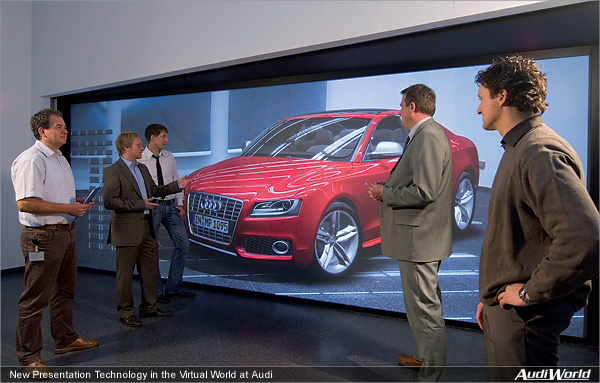New Presentation Technology in the Virtual World at Audi: From Silver Screen to Automotive Development

Audi has become the first car manufacturer in Europe to adopt a new presentation technology of digital cinema quality. It is possible to examine future vehicle models realistically and in detail in the design check and the Data Monitoring Centre at the Virtual Reality (VR) Studios even before they have been created. The Data Monitoring Centre visualises vehicle projects authentically on the basis of design data. These are then presented to the Board Member responsible, who takes the data and approves it for the production process of creating operating materials and equipment. “The new technology in the Data Monitoring Centre serves as an interface between man and technology in the production release process,” explains VR developer Carsten Huschka. “The entire visible vehicle surface is examined to guarantee the quality look that the customer perceives and expects.” The projector that makes such presentations possible was actually intended for digital cinema and is made by Sony Business Systems. The Sony SRX-S110 4K projector (Silicon X-tal Reflective Display) shows the complex 3D data models from the computers at a resolution of 4,096 x 2,160 active pixels four times as many as the standard for high-definition television. Vehicle models can consequently be presented to their original scale in 5.6 million pixels rising to 7.4 million for the design check on the Powerwall, which measures 6 metres wide by 2.3 metres high. The projection system involves not just one computer, but a whole network of them, featuring the latest Audi computer hardware. The computers are connected up to the projection system by what is known as a pixel processor. This combines the individual elements and can also display other media, such as photos, by the Picture in Picture (PiP) principle. The two new systems at Audi’s design check operations in Technical Development and in the Data Monitoring Centre were created and executed almost concurrently, with the help of Audi’s IT Planning. “Using this projector results in major advantages for the design check,” explained Christian Ziller, coordinator of the project in the design check at Audi. “Without needing to carry out any edge blending, we can now obtain a seamless image and can control even the smallest of details thanks to the high image quality and outstanding contrast,” added Ziller. The design check is a visualisation and decision-making process that aims to avoid the wrong direction being taken in the development process. It starts at the concept phase and ends when a new model is launched on the market. Throughout the process, concepts and current development statuses can be visualised and verified promptly. Here again, the new presentation technology proves beneficial. Virtual camera flights around the exterior and through the vehicle’s interior during the design check and at the Data Monitoring Centre allow the vehicle geometries developed on the computer to be examined very closely. Discrepancies in the surface structure can be recognised immediately and even the smallest of spacings and gaps can be measured precisely. The various materials from the lustre of the paintwork to the fine leather structure have a tangible, “true to life” look. Realistic light conditions such as shadows and reflections give the viewer the impression that it is an actual vehicle on the Powerwall, no matter what angle it is contemplated from. This is enormously useful for data monitoring, because discrepancies in measurements can easily be detected and analysed. The vehicle can then be refined accordingly. The new projector at the Planning Department’s Virtual Reality Studio can now show dimensions for which a battery of six projectors would previously have been necessary. The “edge blending” that needed to be performed under the old method to blend together the overlaps between the images from the separate projectors is now a thing of the past. The new presentation technology not only projects the images seamlessly with optimum results, but also makes it possible to monitor all details precisely thanks to the high-contrast image quality. Discovering virtual worlds at Audi Virtual worlds exist not only in the design check and the Data Monitoring Centre simulation technologies inside and on the vehicle are becoming increasingly common: the rigidity, strength and durability of the body, vibrational comfort, doors, lids, occupant protection, interior components, joining techniques and crash performance can all be represented, as can road behaviour and ride comfort, fuel consumption, sensing technology, aerodynamics and aeroacoustics, air conditioning, headlights, suspension response and the combustion process in the engine. The list is almost endless. Audi currently uses around 250 different simulation methods productively in Technical Development. Staff from the toolmaking, production and prototyping areas are also involved in the early phase of vehicle planning. In keeping with the “Digital Factory” principle, they can simulate whether and how certain sheet metal parts could conceivably be produced. In an imaginary factory hall, they can investigate where the robots set which weld points and precisely where they need to be positioned to avoid any clashes. At a stage where often not a single component of the vehicle has yet been made, every detail can be represented, considered and examined in the virtual world. Vehicles can be considered from every conceivable perspective, and any combination of exterior colour and equipment can be configured and called up in a matter of seconds. Dr. Ulrich Widmann, Head of Vehicle Safety Development, stressed how simulation technology has become indispensable. “A vehicle is a complex structure with a great many characteristics. It would be quite simply impossible to develop and then check them all in physical tests. This mammoth task can only be handled thanks to the infinite number of simulations that are possible in the virtual world.” |
